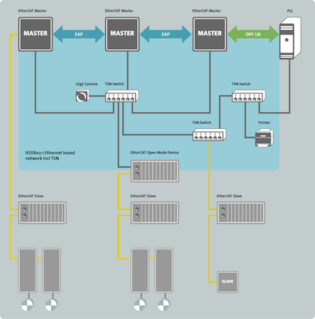Time Sensitive Networking (TSN) defines the future of networking. Most of the specifications have been agreed upon by the IEEE 802 committee, only a few remain to be completed. I have written a White Paper describing OPC UA over TSN for information communication. This corroborates the idea that information is where the new momentum lies within manufacturing and production technologies.
One topic of concern to many regards whether or not TSN will supplant current fieldbus technologies. Indeed, on the surface it appears that TSN can perform most, if not all, of those functions.
Therefore, it behooves the fieldbus groups to figure out how to work with this new technology in order to add value for users.
The EtherCAT Technology Group (ETG) has taken the initiative and supplemented EtherCAT with Time Sensitive Networking (TSN) technologies, expanding the field of possible EtherCAT applications to include heterogeneous network environments. With the help of TSN, industrial controls can contact a number of different EtherCAT segments in real-time through Ethernet networks.

In doing so, no changes to the EtherCAT slave devices are required: the EtherCAT Device Protocol, including all high performance characteristics, is fully preserved. Also expanded by TSN is the EtherCAT Automation Protocol (EAP) for communication between controls, which will result in even more deterministic performance on this level.
The ETG has specified the technology expansion in the form of a profile, which highlights the fact that no changes to the TSN standards are needed. This approach also considerably simplifies the adaptation to the final versions of the TSN technologies, because specification in the IEEE is not yet fully complete.
The ETG has supported the development of TSN from the very beginning through active participation in the IEEE committee, and is coordinating the specifications through a liaison with the IEEE 802.1 Working Group. This ensures that the ETG will also be able to access the IEEE 802.1 specifications that have not yet been adopted. Therefore, the technology can be introduced almost at the same time as TSN.
EtherCAT uses the TSN streams with any data rates for real-time communication above EtherCAT device segments. In the segment itself nothing is changed – the unique performance of the EtherCAT protocol built upon processing on the fly, highly precise synchronization, flexible topology selection, excellent diagnostic capabilities and simplicity through fully automated addressing of devices are all fully preserved. Similarly, the thousands of different EtherCAT devices available worldwide do not need to be modified at all. The stream adaptation feature that connects the EtherCAT segment to the heterogeneous TSN network can be placed either in the last TSN switch or in the first EtherCAT slave device.
Dr. Guido Beckmann, Chairman of the ETG Technical Committee classifies the new specification as such: “The incorporation of TSN standards will significantly improve the real-time characteristics of generic Ethernet. With our technology expansion we make use of TSN in an ideal way, and exactly where TSN can offer significant advantages – in the factory networks. As one frame is sufficient for EtherCAT to communicate with a whole segment, and thus with the entire fieldbus network, EtherCAT is virtually predestined for integration with TSN networks. We achieve this without turning our technology inside out. EtherCAT together with TSN offers the ‘best of both worlds’. Therefore, this prepares EtherCAT for the future perfectly.”




